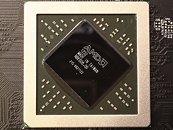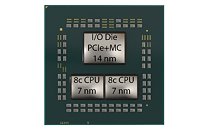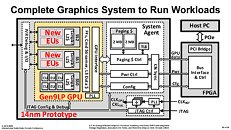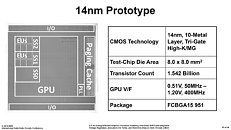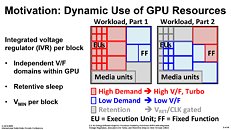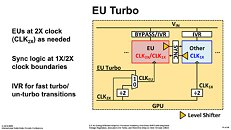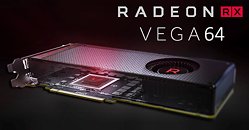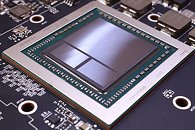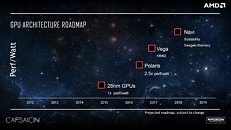Apr 10th, 2025 04:12 EDT
change timezone
Latest GPU Drivers
New Forum Posts
- Do you use Linux? (572)
- Help with updating firmware on a AOC Agon Pro OLED monitor, says I need Install Tool (3)
- HP EliteDesk 800 G2 SFF CPU support (2)
- Anyone know where to get driver updates / backdates for TUF A15? (4)
- EK Quantum Velocity intel to amd conversion (13)
- [Update] FanControl (and other different monitoring software) blocked by Defender due to Winring0 vulnerability (1)
- How is the Gainward Phoenix Model in terms of quality? (0)
- ## [Golden Sample] RTX 5080 – 3300 MHz @ 1.020 V (Stock Curve) – Ultra-Stable & Efficient (44)
- hp envy 15 rtx 2060 max-q stock vbios (1)
- (Some of) What I'd like to See From a Final Fantasy IX Remake (10)
Popular Reviews
- The Last Of Us Part 2 Performance Benchmark Review - 30 GPUs Compared
- ASRock Z890 Taichi OCF Review
- MCHOSE L7 Pro Review
- Sapphire Radeon RX 9070 XT Pulse Review
- PowerColor Radeon RX 9070 Hellhound Review
- Upcoming Hardware Launches 2025 (Updated Apr 2025)
- Sapphire Radeon RX 9070 XT Nitro+ Review - Beating NVIDIA
- Acer Predator GM9000 2 TB Review
- ASUS GeForce RTX 5080 Astral OC Review
- UPERFECT UStation Delta Max Review - Two Screens In One
Controversial News Posts
- NVIDIA GeForce RTX 5060 Ti 16 GB SKU Likely Launching at $499, According to Supply Chain Leak (174)
- MSI Doesn't Plan Radeon RX 9000 Series GPUs, Skips AMD RDNA 4 Generation Entirely (146)
- Microsoft Introduces Copilot for Gaming (124)
- AMD Radeon RX 9070 XT Reportedly Outperforms RTX 5080 Through Undervolting (119)
- NVIDIA Reportedly Prepares GeForce RTX 5060 and RTX 5060 Ti Unveil Tomorrow (115)
- Over 200,000 Sold Radeon RX 9070 and RX 9070 XT GPUs? AMD Says No Number was Given (100)
- Nintendo Switch 2 Launches June 5 at $449.99 with New Hardware and Games (99)
- Nintendo Confirms That Switch 2 Joy-Cons Will Not Utilize Hall Effect Stick Technology (99)
News Posts matching #RTG
Return to Keyword Browsing
Forza Motorsport Gets Ray-Traced Global Illumination in December 9 Visual Update
Forza Motorsport, Xbox Studios's cinematic 2023 live-service racing sim, is getting a nice visual upgrade in an upcoming update (titled Update 15) shortly after the first anniversary of its release. On December 9, Forza Motorsport will get Ray-Traced Global Illumination (RTGI), making the racing game and all its shiny cars look more realistic. RTGI will be available for all PC versions of Forza Motorsport as of December 9—as long as the game is up-to-date that is—although it will need to be manually enabled in the game's graphics settings. After being enabled, RTGI will apply to both gameplay rendering and in-game cinematics, as well as the built-in photo mode.
While Forza Motorsport's minimum recommended GPU specification is an NVIDIA GeForce GTX 1060, you will need at least an NVIDIA GeForce RTX 20-series or AMD RX 6000-series graphics card to take advantage of RTGI, with the game's developer, Turn 10, recommending an NVIDIA GeForce RTX 3080 or better for high graphics and RTGI settings. For the uninitiated, RTGI helps increase realism by simulating how light interacts with surfaces and materials, more accurately rendering indirect lighting and shadows in-game. In NVIDIA's blog post announcing the updated visuals for Forza Motorsport, it recommends using the RTGI in conjunction with DLSS Super Resolution or DLAA to get the highest frame rates. Forza Motorsport is available for PC on Steam (currently 50% off), the Microsoft Store, and PC Game Pass
While Forza Motorsport's minimum recommended GPU specification is an NVIDIA GeForce GTX 1060, you will need at least an NVIDIA GeForce RTX 20-series or AMD RX 6000-series graphics card to take advantage of RTGI, with the game's developer, Turn 10, recommending an NVIDIA GeForce RTX 3080 or better for high graphics and RTGI settings. For the uninitiated, RTGI helps increase realism by simulating how light interacts with surfaces and materials, more accurately rendering indirect lighting and shadows in-game. In NVIDIA's blog post announcing the updated visuals for Forza Motorsport, it recommends using the RTGI in conjunction with DLSS Super Resolution or DLAA to get the highest frame rates. Forza Motorsport is available for PC on Steam (currently 50% off), the Microsoft Store, and PC Game Pass

AMD Wins Back Three Graphics Patents from LG
AMD won back ownership of three graphics patents that had earlier been struck down on a complaint by LG Electronics. A U.S. Court of Appeals for the Federal Circuit overruled a ruling of the Patent Trial and Appeal Board (PTAB) which observed that AMD subsidiary ATI Technologies ULC (now reorganized as RTG), has a claim to U.S. patents numbered 7,742,053, 6,897,871, and 7,327,369. The three patents deal with critical technology related to Unified Shaders.
The PTAB had earlier dismissed ATI's ownership of the patents on grounds that the IP claimed was "too obvious in light of prior art." A bench of three Judges in a unanimous decision ruled that ATI had "had conceived of their inventions before the prior art." Put simply, the court was satisfied that the technologies protected by these patents were invented by ATI before the "prior art," and were not "obvious next steps" to it.
The PTAB had earlier dismissed ATI's ownership of the patents on grounds that the IP claimed was "too obvious in light of prior art." A bench of three Judges in a unanimous decision ruled that ATI had "had conceived of their inventions before the prior art." Put simply, the court was satisfied that the technologies protected by these patents were invented by ATI before the "prior art," and were not "obvious next steps" to it.

Intel Soaks Up Heather Lennon, AMD RTG Digital Marketing Head
Intel has hired another of AMD's top executives as Raja Koduri hopes to basically rebuild RTG under Intel's banner and its resources. This time it's Heather Lennon, who led AMD Radeon Technologies Group (RTG) marketing and had been with AMD for over 10 years. She directed the Team Red community and won PR Week award for Campaign of the Year 2014. Lennon bagged 40 awards for digital marketing for AMD, and is widely believed to be the brains behind the PR upper-hand AMD enjoys among tech forums and the DIY community.
Lennon now joins Intel as Senior Manager, Digital Marketing for Graphics, and will work closely with Mark Taylor, an ex-NVIDIA exec who now leads technical marketing at Intel Graphics. Other ex-AMD and ex-NVIDIA honchos include Chris Hook and Tom Peterson, respectively. Raja Koduri is overseeing Intel's ambitious project to make inroads to the discrete GPU market under the new Xe brand, not just to serve gamers and PC enthusiasts, but more importantly GPU compute, cloud compute, and AI markets. Koduri is also reportedly lending insights to Intel's new Gen11 integrated graphics architecture, which debuts with its 10 nm "Ice Lake" processors.
Lennon now joins Intel as Senior Manager, Digital Marketing for Graphics, and will work closely with Mark Taylor, an ex-NVIDIA exec who now leads technical marketing at Intel Graphics. Other ex-AMD and ex-NVIDIA honchos include Chris Hook and Tom Peterson, respectively. Raja Koduri is overseeing Intel's ambitious project to make inroads to the discrete GPU market under the new Xe brand, not just to serve gamers and PC enthusiasts, but more importantly GPU compute, cloud compute, and AI markets. Koduri is also reportedly lending insights to Intel's new Gen11 integrated graphics architecture, which debuts with its 10 nm "Ice Lake" processors.

AMD to Simultaneously Launch 3rd Gen Ryzen and Unveil Radeon "Navi" This June
TAITRA, the governing body behind the annual Computex trade-show held in Taipei each June, announced that AMD CEO Dr. Lisa Su will host a keynote address which promises to be as exciting as her CES keynote. It is revealed that Dr. Su will simultaneously launch or unveil at least four product lines. High up the agenda is AMD's highly anticipated 3rd generation Ryzen desktop processors in the socket AM4 package, based on "Zen 2" microarchitecture, and a multi-chip module (MCM) codenamed "Matisse." This launch could be followed up by a major announcement related to the company's 2nd generation EPYC enterprise processors based on the "Rome" MCM.
PC enthusiasts are in for a second major announcement, this time from RTG, with a technical reveal or unveiling of Radeon "Navi," the company's first GPU designed from the ground up for the 7 nm silicon fabrication process. It remains to be seen which market-segment AMD targets with the first "Navi" products, and the question on everyone's minds, whether AMD added DXR acceleration, could be answered. Lastly, the company could announce more variants of its Radeon Instinct DNN accelerators.
PC enthusiasts are in for a second major announcement, this time from RTG, with a technical reveal or unveiling of Radeon "Navi," the company's first GPU designed from the ground up for the 7 nm silicon fabrication process. It remains to be seen which market-segment AMD targets with the first "Navi" products, and the question on everyone's minds, whether AMD added DXR acceleration, could be answered. Lastly, the company could announce more variants of its Radeon Instinct DNN accelerators.

AMD Radeon Technology Group, Senior VP and General Manager, Mike Rayfield to Resign
AMD's Radeon Technology Group (RTG) continues to be in a state of flux, with another executive leaving the company. This time, RTG General Manager and Senior Vice President, Mike Rayfield (pictured on the left below) will be resigning by year's end, marking the second time in a calendar year the group has been devoid of a formal leader. Rayfield previously worked for NVIDIA as the General Manager of their Tegra business unit, and was Vice President and General Manager of Micron's mobile storage business unit prior to that. Having served in all these roles for quite some time, it is somewhat of a surprise to see him leaving AMD so quickly, having only just joined the company back in February 2018. With that said, AMD has said the reason for this departure is so that he can "spend more time with his family and pursue his personal passions".
David Wang (picture on the right below), the current Senior Vice President of Engineering at RTG, will be his interim successor. He already has a storied history at AMD, having worked on ATI/AMD graphics cards as a GPU engineer from the R300 to GCN 1.0 in a time period ranging from the years 2000 to 2012. Under AMD's dual leadership model which was implemented after Raja Koduri's resignation, both Wang and Rayfield have worked together leading the RTG group. Thanks to this, the transition of duties should be relatively smooth even though Wang's role is only temporary, and it will be interesting to see whom AMD picks as Rayfield's long-term successor.
David Wang (picture on the right below), the current Senior Vice President of Engineering at RTG, will be his interim successor. He already has a storied history at AMD, having worked on ATI/AMD graphics cards as a GPU engineer from the R300 to GCN 1.0 in a time period ranging from the years 2000 to 2012. Under AMD's dual leadership model which was implemented after Raja Koduri's resignation, both Wang and Rayfield have worked together leading the RTG group. Thanks to this, the transition of duties should be relatively smooth even though Wang's role is only temporary, and it will be interesting to see whom AMD picks as Rayfield's long-term successor.

Ex-Hardware.fr GPU Editor Damien Triolet Jumps Ship from AMD RTG to Intel
Oh hey remember this news post from July last year? Damien Triolet's work history off-late has been one of many such recent stories. These tend to begin with AMD, and RTG in particular, getting a cash infusion and growing in 2016 and 2017 to where they hired some of the best engineers and marketing personnel from the industry- media or otherwise. This follows a more stagnant GPU division in 2017-2018, Intel deciding to dip their toes back into the discrete GPU market, and in turn.. persuading many to cross over to the blue side.
According to Damien's LinkedIn and FaceBook profiles, he has started working for Intel from November 26, 2018 in a technical marketing position in their Gaming and Graphics division, a role analogous to his from his days at AMD. Presumably, he joins Raja Koduri and the many others who have followed this exact path of late, and everyone remains curious as to what the finished retail product will be. In the meantime, we here at TechPowerUp wish him the best again for his new venture. We had the pleasure of interacting with Damien on multiple occasions in the past, some as colleagues in the media giving hardware manufacturers a hard time, and others when he was hosting us as an AMD employee. His tenure at Hardware.fr has been inspiring to us, with excellent reviews that no doubt were what caught the eyes of AMD in the first place, and Intel will definitely gain from his presence.
According to Damien's LinkedIn and FaceBook profiles, he has started working for Intel from November 26, 2018 in a technical marketing position in their Gaming and Graphics division, a role analogous to his from his days at AMD. Presumably, he joins Raja Koduri and the many others who have followed this exact path of late, and everyone remains curious as to what the finished retail product will be. In the meantime, we here at TechPowerUp wish him the best again for his new venture. We had the pleasure of interacting with Damien on multiple occasions in the past, some as colleagues in the media giving hardware manufacturers a hard time, and others when he was hosting us as an AMD employee. His tenure at Hardware.fr has been inspiring to us, with excellent reviews that no doubt were what caught the eyes of AMD in the first place, and Intel will definitely gain from his presence.

Intel Scores Another Top AMD Exec - Chris Hook Confirmed to Join Company
Chris Hook, the head of marketing at AMD Radeon Technologies Group (RTG), who resigned from AMD a few weeks ago, joined Intel. Hook will hold the position of head of discrete graphics marketing, confirming rumors of Intel making heavy investments into the development of a discrete GPU that can double up as a super-scalar processor, enabling the company to compete with NVIDIA and AMD for slices of the AI and blockchain computing gold-rush, with PC gaming as a fallback market. Jim Keller, Raja Koduri, and Chris Hook make up key names from AMD to have joined Intel in recent times. Keller was the lead architect of AMD "Zen," who after a brief stint at Tesla, joined Intel earlier this month.

Ryzen Architect Jim Keller Joins Intel
Jim Keller, the VLSI guru who led the team behind AMD's spectacular comeback in the x86 processor market with "Zen," has reportedly quit his job at Tesla to join AMD's bête noire, Intel. Following his work on "Zen," Keller had joined Tesla to work on self-driving car hardware. Keller joins Raja Koduri at Intel, the other big former-AMD name, who led Radeon Technologies Group (RTG).
PC Perspective comments that big names like Keller and Koduri joining Intel could provide clues as to Intel's current state and the direction it's heading in. The company appears to be in a state of shake-up from a decade of complacency and lethargy in its core business. Koduri could be putting together a team of people familiar to him for a new clean-slate project. The last time Intel had a clean slate was ten years ago, with "Nehalem."
PC Perspective comments that big names like Keller and Koduri joining Intel could provide clues as to Intel's current state and the direction it's heading in. The company appears to be in a state of shake-up from a decade of complacency and lethargy in its core business. Koduri could be putting together a team of people familiar to him for a new clean-slate project. The last time Intel had a clean slate was ten years ago, with "Nehalem."

Top Level AMD Veteran Chris Hook Leaving the Company
After Raja Koduri left AMD in a low-profile-turned-high-profile leave of absence, ending up as head for rival Intel's newly formed Core and Visual Computing Group, now it's time for another high-level player to leave the company. AMD's Chris Hook has been in the company for almost two decades, rising from the bottom up towards the enviable position (at times) to lead the entire AMD's Radeon Technologies' Group Marketing Department since October 2017.
In a Facebook post detailing his departure, Hook joked that when he first joined the company, "ATI still had a smoking room, there was only one TV in the office (a small 14" black and white version we crowded into a room to watch 9/11 on), transistor size was still measured in microns, and 320x240 was considered 'high res'." Chris Hook has led (or been in the next closest position) as the public-facing effort of ATI/AMD-RTG and AMD core marketing team for a while now, so him leaving the company at a time where the global GPU marketshare is better than it ever has been in years does give some food for thought. Some publications are speculating on a move from AMD to Intel, similar to Raja Koduri's, citing close relationships between both men and the need for Intel to eventually market some products originating from their Core and Visual Computing Group (maybe with Arctic Sound?)
In a Facebook post detailing his departure, Hook joked that when he first joined the company, "ATI still had a smoking room, there was only one TV in the office (a small 14" black and white version we crowded into a room to watch 9/11 on), transistor size was still measured in microns, and 320x240 was considered 'high res'." Chris Hook has led (or been in the next closest position) as the public-facing effort of ATI/AMD-RTG and AMD core marketing team for a while now, so him leaving the company at a time where the global GPU marketshare is better than it ever has been in years does give some food for thought. Some publications are speculating on a move from AMD to Intel, similar to Raja Koduri's, citing close relationships between both men and the need for Intel to eventually market some products originating from their Core and Visual Computing Group (maybe with Arctic Sound?)

Intel Unveils Discrete GPU Prototype Development
Intel is making progress in its development of a new discrete GPU architecture, after its failed attempt with "Larrabee" that ended up as an HPC accelerator; and ancient attempts such as the i740. This comes in the wake of the company's high-profile hiring of Raja Koduri, AMD's former Radeon Technologies Group (RTG) head. The company unveiled slides pointing to the direction in which its GPU development is headed, at the IEEE International Solid-State Circuits Conference (ISSCC) in San Francisco. That direction is essentially scaling up its existing iGPU architecture, and bolstering it with mechanisms to sustain high clock speeds better.
The company's first 14 nm dGPU prototype, shown as a test-chip at the ISSCC, is a 2-chip solution. The first chip contains two key components, the GPU itself, and a system agent; and the second chip is an FPGA that interfaces with the system bus. The GPU component, as it stands now, is based on Intel's Gen 9 architecture, and features a three execution unit (EU) clusters. Don't derive numbers from this yet, as Intel is only trying to demonstrate a proof of concept. The three clusters are wired to a sophisticated power/clock management mechanism that efficiently manages power and clock-speed of each individual EU. There's also a double-clock mechanism that doubles clock speeds (of the boost state) beyond what today's Gen 9 EUs can handle on Intel iGPUs. Once a suitable level of energy efficiency is achieved, Intel will use newer generations of EUs, and scale up EU counts taking advantage of newer fab processes, to develop bigger discrete GPUs.More slides follow.
The company's first 14 nm dGPU prototype, shown as a test-chip at the ISSCC, is a 2-chip solution. The first chip contains two key components, the GPU itself, and a system agent; and the second chip is an FPGA that interfaces with the system bus. The GPU component, as it stands now, is based on Intel's Gen 9 architecture, and features a three execution unit (EU) clusters. Don't derive numbers from this yet, as Intel is only trying to demonstrate a proof of concept. The three clusters are wired to a sophisticated power/clock management mechanism that efficiently manages power and clock-speed of each individual EU. There's also a double-clock mechanism that doubles clock speeds (of the boost state) beyond what today's Gen 9 EUs can handle on Intel iGPUs. Once a suitable level of energy efficiency is achieved, Intel will use newer generations of EUs, and scale up EU counts taking advantage of newer fab processes, to develop bigger discrete GPUs.More slides follow.

Graphics Industry Leaders Mike Rayfield and David Wang Join AMD
AMD today announced the appointment of Mike Rayfield as senior vice president and general manager of AMD Radeon Technologies Group (RTG), and David Wang as senior vice president of engineering for RTG. Both will report to President and CEO Dr. Lisa Su. Rayfield will be responsible for all aspects of strategy and business management for AMD's graphics business including consumer graphics, professional graphics, and semi-custom products. Wang will be responsible for all aspects of graphics engineering, including the technical strategy, architecture, hardware, and software for AMD graphics products and technologies.
"Mike and David are industry leaders who bring proven track records of delivering profitable business growth and leadership product roadmaps," said AMD President and CEO Dr. Lisa Su. "We enter 2018 with incredible momentum for our graphics business based on the full set of GPU products we introduced last year for the consumer, professional, and machine learning markets. Under Mike and David's leadership, I am confident we will continue to grow the footprint of Radeon across the gaming, immersive, and GPU compute markets."
"Mike and David are industry leaders who bring proven track records of delivering profitable business growth and leadership product roadmaps," said AMD President and CEO Dr. Lisa Su. "We enter 2018 with incredible momentum for our graphics business based on the full set of GPU products we introduced last year for the consumer, professional, and machine learning markets. Under Mike and David's leadership, I am confident we will continue to grow the footprint of Radeon across the gaming, immersive, and GPU compute markets."

Intel Hires Raja Koduri, to Develop Discrete GPUs, This Time for Real
Intel hired Raja Koduri, who resigned as head of AMD's Radeon Technologies Group (RTG), earlier this week. Koduri has been made Senior Vice President and Chief Architect of Intel's future discrete GPUs. That's right, Intel has renewed its dreams to power high-end graphics cards that compete with AMD and NVIDIA. Intel's last attempt at a discrete GPU was "Larrabee," which evolved into a super-scalar multi-core processor for HPC applications under the Xeon Phi line.
This development heralds two major theories. One, that Intel's collaboration with AMD RTG on graphics IP could only go further from here, and what is a multi-chip module of Intel and AMD IP now, could in the future become a true heterogeneous die of Intel's and AMD's IP. Two, that the consolidation of AMD's graphics assets and IP into a monolithic entity as RTG, could make it easier to sell it lock, stock, and barrel, possibly to Intel.
This development heralds two major theories. One, that Intel's collaboration with AMD RTG on graphics IP could only go further from here, and what is a multi-chip module of Intel and AMD IP now, could in the future become a true heterogeneous die of Intel's and AMD's IP. Two, that the consolidation of AMD's graphics assets and IP into a monolithic entity as RTG, could make it easier to sell it lock, stock, and barrel, possibly to Intel.

AMD Confirms Raja Koduri's Departure, CEO Lisa Su Interim RTG Head
AMD late Tuesday confirmed the departure of Raja Koduri as head of the company's Radeon Technologies Group (RTG). Koduri had been on a "sabbatical" since September. Company CEO Lisa Su, who has been directly heading RTG, will continue to do so, until a replacement is found. AMD in its statement confirming Koduri's departure, assured all concerned (particularly investors), that there will be no change in the group's plans and the strategic direction in which it's heading.
"Earlier today, we announced two unrelated updates for our Radeon Technologies Group: 1) Raja Koduri has decided to leave AMD and 2) we are taking the next steps in our work to strengthen RTG by further focusing the organization on key growth areas," said Drew Prairie from corporate communications at AMD. "I wanted to also make sure you understood these updates do not impact our plans or the strategic direction we are driving our graphics business," he continued.
"Earlier today, we announced two unrelated updates for our Radeon Technologies Group: 1) Raja Koduri has decided to leave AMD and 2) we are taking the next steps in our work to strengthen RTG by further focusing the organization on key growth areas," said Drew Prairie from corporate communications at AMD. "I wanted to also make sure you understood these updates do not impact our plans or the strategic direction we are driving our graphics business," he continued.

AMD Radeon Boss Raja Koduri Jumps Ship
As we reported back in September, Raja Koduri took a sabbatical leave from AMD's Radeon Technologies Group (RTG) to find himself. AMD CEO Lisa Su was left in charge during this time as Raja wasn't expected to return until December. However, our friends over at Hexus got their hands on a memo that Raja left to this team revealing his intentions to leave the company for good.

Raja Koduri On a Sabbatical from RTG till December, AMD CEO Takes Over
Raja Koduri, chief of AMD's Radeon Technologies Group (RTG), has reportedly taken an extended leave from the company, running up to December 2017. Ryan Shrout, editor of PC Perspective stated that he got confirmation from the company about this development. Company CEO Lisa Su has taken direct control over RTG in the meantime.
Formed in 2015 after a major internal reorganization, RTG handles a bulk of AMD's graphics IP, developing and marketing products under the Radeon brand, including Radeon RX series consumer graphics chips, Radeon Pro series professional graphics chips, and Radeon Instinct line of GPGPU accelerators. This move is of particular significance as Q4 tends to be the biggest revenue quarter, as sales rally on account of Holiday.
Formed in 2015 after a major internal reorganization, RTG handles a bulk of AMD's graphics IP, developing and marketing products under the Radeon brand, including Radeon RX series consumer graphics chips, Radeon Pro series professional graphics chips, and Radeon Instinct line of GPGPU accelerators. This move is of particular significance as Q4 tends to be the biggest revenue quarter, as sales rally on account of Holiday.

On AMD's Raja Koduri RX Vega Tweetstorm
In what is usually described as a tweetstorm, AMD's RTG leader Raja Koduri weighed in on AMD's RX Vega reception and perception from both the public and reviewers. There are some interesting tidbits there; namely, AMD's option of setting the RX vega parts at frequencies and voltages outside the optimal curve for power/performance ratios, in a bid to increase attractiveness towards the performance/$ crowds.
However, it can be said that if AMD had done otherwise, neither gamers nor reviewers would have been impressed with cards that potentially delivered less performance than their NVIDIA counterparts, while consuming more power all the same (even if consuming significantly less wattage). At the rated MSRP (and that's a whole new discussion), this RTG decision was the best one towards increasing attractiveness of RX Vega offerings. However, Raja Koduri does stress Vega's dynamic performance/watt ratios, due to the usage of specially defined power profiles.To our forum-walkers: this piece is marked as an editorial
However, it can be said that if AMD had done otherwise, neither gamers nor reviewers would have been impressed with cards that potentially delivered less performance than their NVIDIA counterparts, while consuming more power all the same (even if consuming significantly less wattage). At the rated MSRP (and that's a whole new discussion), this RTG decision was the best one towards increasing attractiveness of RX Vega offerings. However, Raja Koduri does stress Vega's dynamic performance/watt ratios, due to the usage of specially defined power profiles.To our forum-walkers: this piece is marked as an editorial

AMD Announces Radeon Vega Frontier Edition - Not for Gamers
Where is Vega? When is it launching? On AMD's Financial Analyst Day 2017, Raja Koduri spoke about the speculation in the past few weeks, and brought us an answer: Radeon Vega Frontier Edition is the first iteration of Vega, aimed at data scientists, immersion engineers and product designers. It will be released in the second half of June for AMD's "pioneers". The wording, that Vega Frontier Edition will be released in the second half of June, makes it so that AMD still technically releases Vega in the 2H 2017... It's just not the consumer, gaming Vega version of the chip. This could unfortunately signify an after-June release time-frame for consumer GPUs based on the Vega micro-architecture.
This news comes as a disappointment to all gamers who have been hoping for Vega for gaming, because it reminds of what happened with dual Fiji. A promising design which ended up unsuitable for gaming and was thus marketed for content creators as Radeon Pro Duo, with little success. But there is still hope: it just looks like we really will have to wait for Computex 2017 to see some measure of details on Vega's gaming prowess.
This news comes as a disappointment to all gamers who have been hoping for Vega for gaming, because it reminds of what happened with dual Fiji. A promising design which ended up unsuitable for gaming and was thus marketed for content creators as Radeon Pro Duo, with little success. But there is still hope: it just looks like we really will have to wait for Computex 2017 to see some measure of details on Vega's gaming prowess.

AMD to Detail Vega, Navi, Zen+ on May 16th - Laying Out a Vision
Reports are circling around the web regarding an AMD meeting featuring some of its higher ups - namely, CEO Lisa Su, head of Radeon Technologies Group Raja Koduri, and AMD's CTO Mark Papermaster happening on the 16th of May. The purpose of this meeting seems to be to discuss AMD's inflexion point, and lay out a vision for the company's future, supported on its upcoming products: the too-long-awaited Vega, its successor Navi, and the natural evolution of the company's current Zen processors, tentatively identified as Zen+.
Naturally, a company such as AMD has its roadmap planned well in advance, with work on next-generation products and technologies sometimes even running in parallel with current-generation product development. It's just a result of the kind of care, consideration, time and money that goes into making new architectures that makes this so. And while some would say Vega is now approaching a state akin to grapes that have been hanging for far too long, AMD's next graphics architecture, Navi, and its iterations on Zen cores, which the company expect to see refreshes in a 3-to-5-year period, are other matters entirely. Maybe we'll have some more details regarding the specific time of Vega's launch (for now expected on Computex), as well as on when AMD is looking to release a Zen+ refresh. I wouldn't expect much with regards to Navi - perhaps just an outline on how work is currently underway with some comments on the expectations surrounding Global Foundries' 7 nm process, on which Navi is expected to be built. And no, folks, this isn't a Vega launch. Not yet.
Naturally, a company such as AMD has its roadmap planned well in advance, with work on next-generation products and technologies sometimes even running in parallel with current-generation product development. It's just a result of the kind of care, consideration, time and money that goes into making new architectures that makes this so. And while some would say Vega is now approaching a state akin to grapes that have been hanging for far too long, AMD's next graphics architecture, Navi, and its iterations on Zen cores, which the company expect to see refreshes in a 3-to-5-year period, are other matters entirely. Maybe we'll have some more details regarding the specific time of Vega's launch (for now expected on Computex), as well as on when AMD is looking to release a Zen+ refresh. I wouldn't expect much with regards to Navi - perhaps just an outline on how work is currently underway with some comments on the expectations surrounding Global Foundries' 7 nm process, on which Navi is expected to be built. And no, folks, this isn't a Vega launch. Not yet.
Apr 10th, 2025 04:12 EDT
change timezone
Latest GPU Drivers
New Forum Posts
- Do you use Linux? (572)
- Help with updating firmware on a AOC Agon Pro OLED monitor, says I need Install Tool (3)
- HP EliteDesk 800 G2 SFF CPU support (2)
- Anyone know where to get driver updates / backdates for TUF A15? (4)
- EK Quantum Velocity intel to amd conversion (13)
- [Update] FanControl (and other different monitoring software) blocked by Defender due to Winring0 vulnerability (1)
- How is the Gainward Phoenix Model in terms of quality? (0)
- ## [Golden Sample] RTX 5080 – 3300 MHz @ 1.020 V (Stock Curve) – Ultra-Stable & Efficient (44)
- hp envy 15 rtx 2060 max-q stock vbios (1)
- (Some of) What I'd like to See From a Final Fantasy IX Remake (10)
Popular Reviews
- The Last Of Us Part 2 Performance Benchmark Review - 30 GPUs Compared
- ASRock Z890 Taichi OCF Review
- MCHOSE L7 Pro Review
- Sapphire Radeon RX 9070 XT Pulse Review
- PowerColor Radeon RX 9070 Hellhound Review
- Upcoming Hardware Launches 2025 (Updated Apr 2025)
- Sapphire Radeon RX 9070 XT Nitro+ Review - Beating NVIDIA
- Acer Predator GM9000 2 TB Review
- ASUS GeForce RTX 5080 Astral OC Review
- UPERFECT UStation Delta Max Review - Two Screens In One
Controversial News Posts
- NVIDIA GeForce RTX 5060 Ti 16 GB SKU Likely Launching at $499, According to Supply Chain Leak (174)
- MSI Doesn't Plan Radeon RX 9000 Series GPUs, Skips AMD RDNA 4 Generation Entirely (146)
- Microsoft Introduces Copilot for Gaming (124)
- AMD Radeon RX 9070 XT Reportedly Outperforms RTX 5080 Through Undervolting (119)
- NVIDIA Reportedly Prepares GeForce RTX 5060 and RTX 5060 Ti Unveil Tomorrow (115)
- Over 200,000 Sold Radeon RX 9070 and RX 9070 XT GPUs? AMD Says No Number was Given (100)
- Nintendo Switch 2 Launches June 5 at $449.99 with New Hardware and Games (99)
- Nintendo Confirms That Switch 2 Joy-Cons Will Not Utilize Hall Effect Stick Technology (99)



